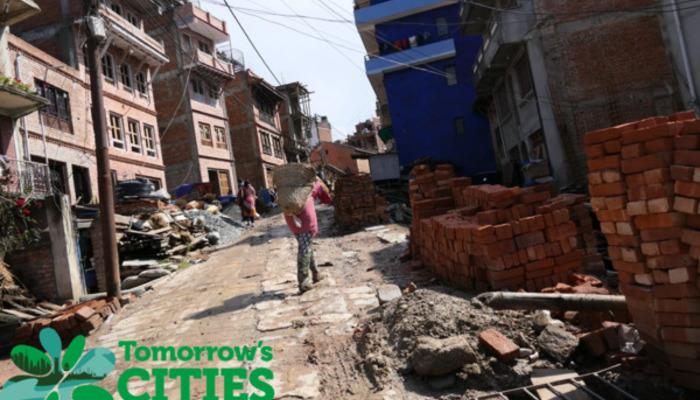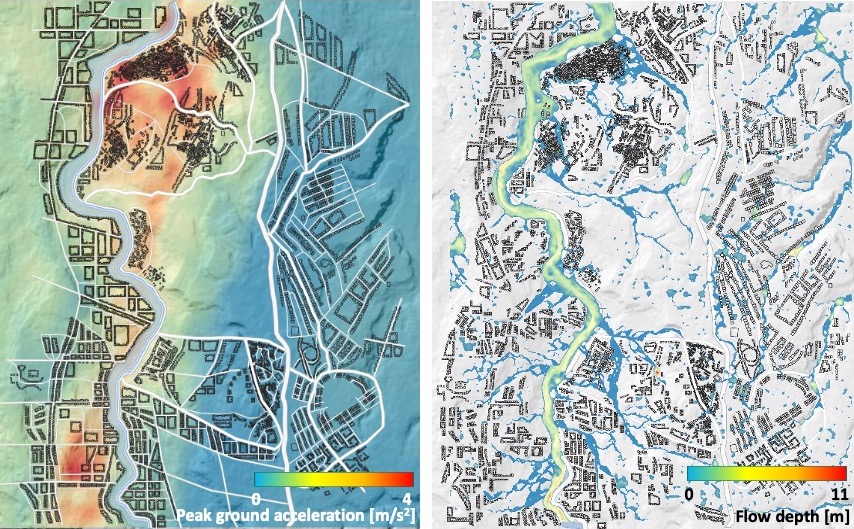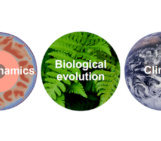
Curious to gain an insight into how we can battle the rapid urbanisation and reduce the disaster risk for the poor people in the future? This week, Dr. Roberto Gentile, Lecturer in Catastrophe Risk Modelling at the Institute for Risk and Disaster Reduction – University College London, talks about the Tomorrow’s Cities Decision Support Environment for risk-informed, pro-poor urban planning, and design. This blog article is authored by Dr. Roberto Gentile and the Early Career Risk Working Group in the Tomorrow’s Cities Hub (in particular, Dr. Maria Evangelina Filippi, Dr. Gemma Cremen, Dr. Luke Jenkins, Dr. Emin Yahya Menteşe, Prof Carmine Galasso, Prof John McCloskey).

Dr. Roberto Gentile is a Lecturer in Catastrophe Risk Modelling at the Institute for Risk and Disaster Reduction at UCL. You can contact him via e-mail or on LinkedIn.
More than two billion people living in cities with low-to-middle income are exposed to a broad spectrum of natural hazards such as floods, earthquakes, landslides, volcanoes, and fires. Climate change has amplified the intensity of these phenomena over the last few years.
Especially, when the urbanisation has contributed to a large expansion at unprecedented rates, which is expected to reach four billion by 2050 (UN-Habitat, 2021). Hazards can impact people’s lives and livelihoods, setting back progress on poverty alleviation and slowing long-term development.
Failure to integrate multi-hazard disaster risk into urban planning and related decision-making processes presents a major barrier to sustainable development. However, this challenge can be also an opportunity, as ~60% of the area is anticipated to be urban by 2030, and we can reduce disaster risk in tomorrow’s cities by design (UN-Habitat, 2021).
Tomorrow’s Cities is the UK Research and Innovation Global Challenges Research Fund Urban Disaster Risk Hub, which is a five-year global interdisciplinary research Hub participating more than 100 academics from nearly 30 institutions in the global North and global South.
Our mission: Reducing disaster risk for the poor in tomorrow’s cities.
We work globally to bring multi-hazard disaster risk management to the centre of urban policy and practice. Our aim is to catalyse a transition from crisis management to multi-hazard risk-informed planning and decision-making that strengthens the voice and capacity of the urban poor.
In order to achieve our mission, we developed the Tomorrow’s Cities Decision Support Environment (TCDSE, Galasso et al. 2021; Cremen et al. 2022a). The TCDSE is the product of a strong interdisciplinary effort among the Hub members, particularly its early-career researchers. The framework contains a number of interacting modules, providing iterative, evidence-based decision support for risk-informed governance. In essence, it allows city actors, including the urban poor, to co-produce precise future descriptions of a considered urban system (called visioning scenarios) along with physical scientists, urban planners, engineers, and social scientists. Such scenarios include physical and policy considerations representing in detail physical assets, households, and individuals. Each visioning scenario is subjected to different multi-hazard scenarios using a bespoke multi-hazard risk computational model, involving state-of-the-art, physics-based modelling techniques.
The computational model quantifies the physical and social impacts of the multi-hazard scenarios, which are collectively summarised in impact metrics. Next, the resulting impacts are discussed within the context of what we call a “risk agreement” module, which entails multiple stakeholders with diverse perspectives and understandings of risk. This module of the TCDSE aims to transform objective quantifications of impacts into a co-produced subjective definition of “agreed risk”, which considers specific perceptions of different actors, and supports ground-breaking democratisation of the risk concept. Hence, this allows iterating over the visioning scenarios until we can determine those with the optimal agreed risk.

Figure1: Example hazard scenarios modelled for Tomorrowville: Left – earthquake; Right – flood (Jenkins et al., 2022).
Being co-owned from the start by city actors, including the urban poor, the TCDSE enables inclusive, evidence-based policy advocacy and debate around risk-informed urban planning and design. The TCDSE has been designed and demonstrated using a 500-hectare, virtual urban testbed called Tomorrowville, which has been constructed using physical and social data from both Kathmandu and Nairobi to represent a generic Global South city. Tomorrowville is underpinned by a flexible geographic information system (GIS) database that can incorporate detailed data on land-use polygons, physical assets, households, and individuals corresponding to any particular visioning scenario of interest.
The Tomorrow’s Cities Hub is active in disseminating and communicating its ground-breaking TCDSE. A delegation of the Hub participated in the 7th session of the Global Platform for Disaster Risk Reduction (GP2022) in Bali, Indonesia, organised by the United Nations Office for Disaster Risk Reduction (UNDRR), and co-chaired by the Government of Indonesia (23rd-28th May 2022). Tomorrow’s Cities was part of the action throughout GP2022, participating in events and discussions both in-person in Bali and online, hosting an official hybrid side event and an interactive online exhibition booth.
Another delegation from the Hub took part in the European Geoscience Union general assembly 2022 (EGU2022) in Vienna. Tomorrow’s Cities contributed to EGU2022 through a wide variety of presentations focusing on the TCDSE overarching framework (McCloskey et al., 2022, Cremen et al., 2022b, Filippi et al., 2022). In particular, the modules included mapping future visioning scenarios (Dhakal et al., 2022, Mesta et al., 2022, Malamud et al., 2022), stakeholder perceptions (Menteşe et al., 2022), modelling of multiple natural hazards (Jenkins et al., 2022, Tarbali et al., 2022), and their associated physical (Gentile et al., 2022) and social impacts. The work underlying the EGU2022 presentations is collected in several papers that will be contained in a special issue of the International Journal of Disaster Risk Reduction (IJDRR).

Figure 2: Members of the Tomorrow’s Cities Urban Disaster Risk Hub at GP2022 (left) and EGU2022 (right). Left picture, from left to right. Iain Stewart; John McCloskey; Gemma Cremen; Carmine Galasso; Maria Evangelina Filippi. Right picture, from left to right. Yaan Wang, Himanshu Agrawal, Orkut Murat Yilmax, Emin Yayha Menteşe, Roberto Gentile, Aditi Dhakal, Luke Jenkins, Robert Šakić Trogrlić.
The present and future work of the Hub involves the full implementation of the TCDSE in our current four partner cities, namely, Kathmandu (Nepal), Istanbul (Turkey), Quito (Ecuador), and Nairobi (Kenya), as well as expanding into a number of new cities in low-income countries. On that account, we are having a clear impact on the local communities by diverse groups of actors making decisions today for reducing tomorrow’s risks. If you would like to learn more about Tomorrow’s Cities, our TCDSE, and collaborate with us, please get in touch by email at support@tomorrowscities.org.
References Cremen G, Galasso C, McCloskey J.: A Simulation‐Based Framework for Earthquake Risk-Informed and People‐Centered Decision Making on Future Urban Planning. Earth’s Future 10:. https://doi.org/10.1029/2021EF002388, 2022a. Cremen, G. and the Tomorrow’s Cities Early Career Risk Working Group: A State-of-the-Art Approach to Modeling Future Multi-Hazard Risk, supporting People-Centred Decision Making, EGU General Assembly 2022, Vienna, Austria, 23–27 May 2022, EGU22-9686, https://doi.org/10.5194/egusphere-egu22-9686, 2022b. Dhakal, A., Chaudhary, S., Guragain, R., Manandhar, V., Gentile, R., Cremen, G., Galasso, C., and McCloskey, J.: Mapping future exposure to multiple hazards in Tomorrow’s Cities: the Khokana, Kathmandu, Nepal case study, EGU General Assembly 2022, Vienna, Austria, 23–27 May 2022, EGU22-9946, https://doi.org/10.5194/egusphere-egu22-9946, 2022. Filippi, M. E., Sakic Trogrlic, R., Cremen, G., Barcena, A., Mentese, E., Gentile, R., Creed, M., Jenkins, L., Muthusamy, M., Tarbali, K., Dhakal, A., Manandhar, V., Rai, M., Adhikari, S., Kalaycioglu, M., Barake, B., Poudel, D. P., Galasso, C., and McCloskey, J.: Unleashing the power of the interdisciplinary in disaster risk reduction: reflections from an early career researcher group developing a risk-informed decision support environment for Tomorrow’s Cities, EGU General Assembly 2022, Vienna, Austria, 23–27 May 2022, EGU22-10244, https://doi.org/10.5194/egusphere-egu22-10244, 2022. Galasso C, McCloskey J, Pelling M, et al.: Editorial. Risk-based, Pro-poor Urban Design and Planning for Tomorrow’s Cities. International Journal of Disaster Risk Reduction 58:102158. https://doi.org/10.1016/j.ijdrr.2021.102158, 2021. Gentile, R., Manandhar, V., Cremen, G., Jenkins, L., Mentese, E., Guragain, R., Galasso, C., and McCloskey, J.: Characterising the dynamic physical vulnerability of Tomorrow’s Cities to multiple natural hazards, EGU General Assembly 2022, Vienna, Austria, 23–27 May 2022, EGU22-9704, https://doi.org/10.5194/egusphere-egu22-9704, 2022. Jenkins, L., Creed, M., Tarbali, K., Muthusamy, M., Trogrlic, R. S., Phillips, J., Sinclair, H., Galasso, C., and McCloskey, J.: Physics based simulations of multiple hazards for risk sensitive land use planning, EGU General Assembly 2022, Vienna, Austria, 23–27 May 2022, EGU22-10137, https://doi.org/10.5194/egusphere-egu22-10137, 2022. Malamud, B. D., Šakić Trogrlić, R., Hussain, E., Thompson, H., Yahya Menteşe, E., Öner, E., Yolcu, A., Mwangi, E., and Gill, J.: Dynamic risk scenarios for single and multi-hazards in the Global South: Nairobi, Istanbul and Kathmandu, EGU General Assembly 2022, Vienna, Austria, 23–27 May 2022, EGU22-10366, https://doi.org/10.5194/egusphere-egu22-10366, 2022. McCloskey, J., Pelling, M., Cremen, G., Galasso, C., Guragain, R., and Bukachi, V.: A Novel Decision Support Environment for Risk Informed Urban Planning in Tomorrow’s Cities , EGU General Assembly 2022, Vienna, Austria, 23–27 May 2022, EGU22-12300, https://doi.org/10.5194/egusphere-egu22-12300, 2022. Menteşe, E. Y., Trogrlić, R. Š., Hussein, E., Thompson, H., Öner, E., Yolcu, A., and Malamud, B. D.: Stakeholder Perceptions of Multi-hazards and Implications for Urban Disaster Risk Reduction in Istanbul, EGU General Assembly 2022, Vienna, Austria, 23–27 May 2022, EGU22-10895, https://doi.org/10.5194/egusphere-egu22-10895, 2022. Mesta, C., Cremen, G., and Galasso, C.: Modelling increasing natural-hazard risk due to urban growth in Kathmandu Valley, Nepal, EGU General Assembly 2022, Vienna, Austria, 23–27 May 2022, EGU22-5348, https://doi.org/10.5194/egusphere-egu22-5348, 2022. Tarbali, K., McCloskey, J., Agrawal, H., and Galasso, C.: The effects of large-scale geological characteristics on the average spatial pattern of earthquake-induced ground motions, EGU General Assembly 2022, Vienna, Austria, 23–27 May 2022, EGU22-12835, https://doi.org/10.5194/egusphere-egu22-12835, 2022. UN Habitat for a Better Urban Future, 2021. Annual Report 2021. (online) Routledge. Available at: https://unhabitat.org/annual-report-2021 (Accessed 31 May 2022).




